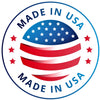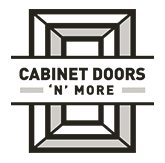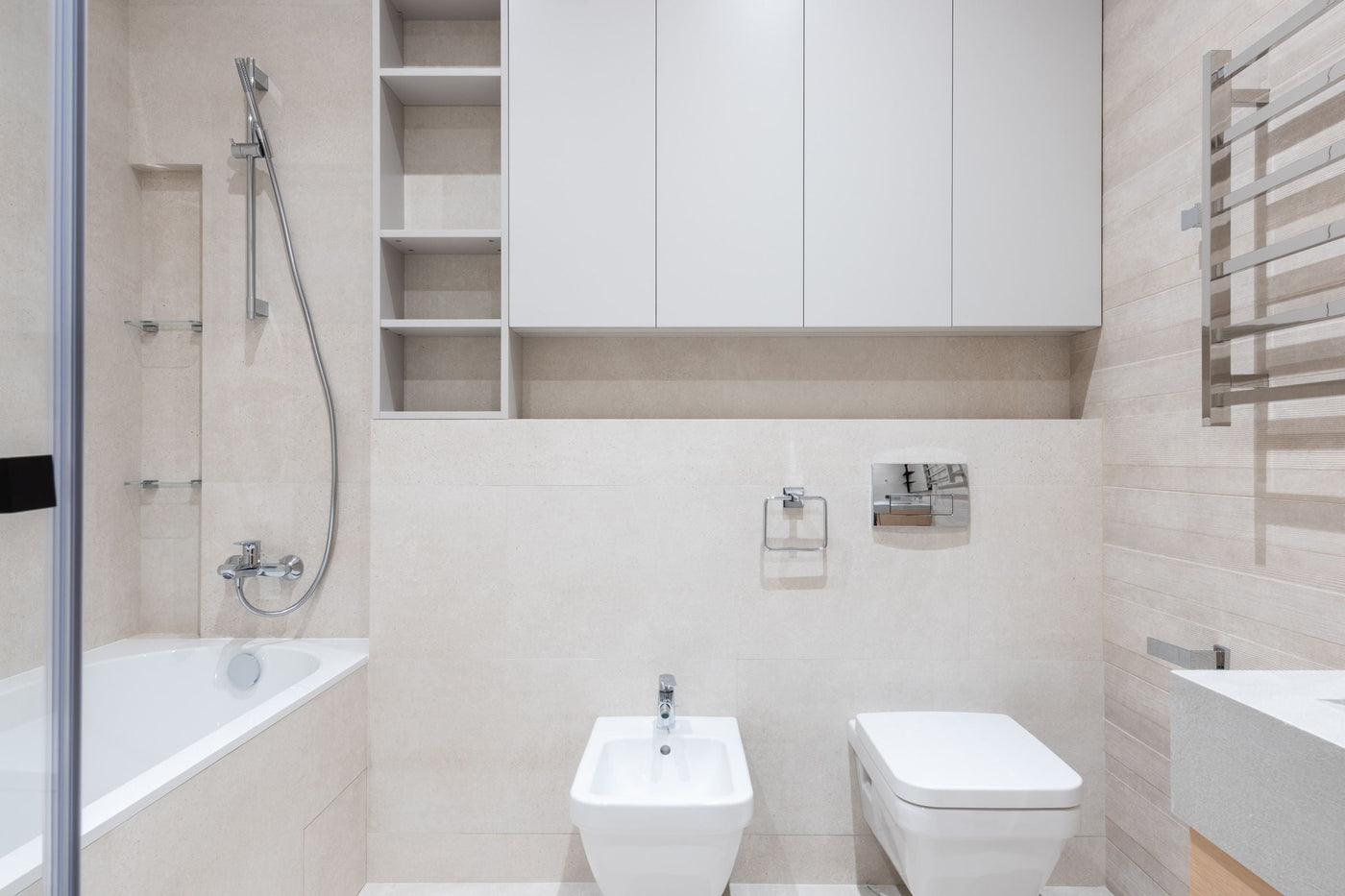
If you need to remodel your bathroom, you'll have to take into consideration the cabinets, light fixtures, tub, shower, tub surround, vanity and type of flooring. The possibilities set before you by manufacturers are seemingly endless. You'll have to find a means to narrow down some of these selections to make your final decision that much easier.
The best way to limit your selection of available choices is to consider how resistant it is to water. Bathrooms are notorious for having high amounts of humidity from showers, baths and even the sink. As a result, you'll want to choose items for your bathroom that can withstand the high amounts of water vapor that will inevitably be in the air.
Here, you'll learn which cabinet materials best suit your needs, what finish to apply for extra protection and other tips and tricks to help keep your new bathroom looking fresh.

HOW DOES HUMIDITY AFFECT BATHROOM CABINETS?
Moisture in your bathroom's air can cause your cabinets to expand. Then, when the air is dry, they shrink. This fluctuation can cause cabinets to warp over time, especially if your bathroom gets very humid when you shower or bathe. You may have visibly crooked cabinets or trouble closing drawers and doors if enough warping and damage has occurred.
If your cabinets are warping, you may also notice cracking or peeling finishes, especially around joints in the wood. While that effect is visually unappealing, it can also lead to further moisture damage over time.
Other than humidity, your bathroom cabinets may face direct water damage. Spills from the sink, splashes from the tub and pooling water from getting out of the shower can seep into your cabinetry and cause the same warping issues, often on a faster scale.
BEST MATERIALS FOR BATHROOM CABINETS
Most bathroom cabinets originate with a wood-based material. You'll need to know which type of material will work best for how your bathroom will function. Does your bathroom have a bathtub or shower? Will it be the main bathroom? Is it purely for aesthetics? Depending on the answer to some of these questions, we can narrow down the type of material that will work best for you.
Here are some of the best materials for bathroom cabinets in almost any situation:

PLYWOOD
Plywood comes with layers of wood veneers glued together to form sheets of varying thickness, durability and quality. Typically, the more sheets the plywood has, the more durable it will be. Plywood consists of thin sheets of wood pressed tightly together. This adds durability, sturdiness and water resistance to the final product.
Plywood tends to be more expensive than other engineered wood options, but it offers great durability and adequate water resistance. You'll have to pay attention to the thickness and density of the wood. Less expensive plywood comes in a softer wood that is less durable. Bathroom cabinets require hardwood and high-density plywood.
Plywood does not deteriorate or damage as easily as materials like particleboard, and while it is still wood, it has much better resistance to water damage. With the proper finish and sealant, you can have a water-resistant vanity at a mid-range price.
Because plywood is not a solid piece of wood, you might be concerned that water could get into the spaces between. But there are generally only gaps between the sheets, which means the front and back are completely solid pieces and can resist water much easier. Veneers, vinyl layers, seals and finishes further protect plywood cabinets. You can certainly find plywood-only cabinets, but you can also buy cabinets with plywood veneers placed on top of a lower-cost core. With veneers, you can take advantage of plywood's appearance and durability with a more cost-effective core material.
The gaps between the sheets also allow for the plywood to easily expand and contract with any moisture, humidity or temperature changes that may occur. You won't have to worry about the plywood cracking or breaking because the gaps between the sheets allow for it to safely expand and contract. When it does occur, you may not even notice the difference. It will still function and look the same.
Overall, plywood is a solid option for bathroom cabinets. It has an affordable price that complements the durability and resistance of the material well. It may not be as durable as solid wood, but with the right sealants, you can get a piece of plywood that has similar characteristics to solid wood without having to pay the premium cost.

SOLID WOOD
One of the best possible materials for your bathroom cabinets will be traditional solid wood. Solid wood has the best durability and strength compared with any other material available.
If you want to invest in the best material possible, solid wood will be the solution for you. Solid wood comes in a variety of different types depending on the tree that the wood comes from. Oakwood is the strongest type you can find, with balsa wood being the weakest.
Overall, hardwoods will be more durable than softwoods. Consider these popular wood types for your bathroom cabinets:
-
Hard maple: Maple hardwood is water-resistant, giving your cabinets a stylish off-white to light brown look that can resist humidity.
-
Cherry: Cherry is a durable hardwood that resists shrinking and warping, making it a durable choice for bathroom cabinets.
Even though solid wood is the best solution for your vanity, note that any solid wood will eventually expand or contract with time and exposure to moisture, especially if your bathroom gets very humid. Overall, the durability and value of solid wood outweigh its potential to warp. Finishing your solid wood cabinets can help protect them even more from moisture in the air.
THERMOFOIL
Rigid thermofoil (RTF) offers a cost-effective yet durable alternative to solid wood cabinets. Manufacturers create these versatile cabinet components with an engineered wood core and a "vinyl" thermofoil material on the surface. Heat and pressure bond the thermofoil to the engineered wood, resulting in a durable and long-lasting cabinet.
The biggest benefit of thermofoil is its moisture resistance. The exterior layer of vinyl creates a nonporous finish, which helps keep water and moisture at bay. As a bonus, thermofoil cabinets are low-maintenance, making them an ideal choice for well-used bathrooms and guest facilities alike.
Thermofoil cabinets are also available in the variety of styles you'd expect to find in solid wood options. Choose from popular styles like Shaker, raised panel, slab and others that suit your bathroom's aesthetics and durability needs.
OTHER MATERIALS FOR BATHROOM CABINETS
While the materials discussed above are some of the most common and moisture-resistant options, there are a few other possibilities. The following options might need modifications to better resist moisture, or they'll be more suitable for bathrooms with less humidity, such as half-baths or guest bathrooms.

PARTICLEBOARD
Particleboard is a compacted sheet of wood shavings, particles and scraps. Manufacturers run these pieces through a machine that combines them with glue, heats the mixture and presses it into the desired shape. Because of the variation in sizes and the types of pieces used, companies sell particleboards by size and density. The denser the piece, the more durable it will be. Keep in mind that bigger pieces may not always be stronger. Density is the best attribute for durability.
What most people will like about particleboard is that it is the cheapest option for your bathroom cabinets. It is relatively easy to make, so it has a lower price point. Unfortunately, that also means particleboard is the least durable option.
While the low price point might entice some of you, you should try to avoid it as a bathroom material as much as possible. It has the lowest water resistance out of the materials mentioned above, and it does not hold up well to the weight of some heavier countertops. The gaps between the separate pieces allow for water particles to seep and make their way inside the particleboard, which can lead to early signs of damage.
If you are remodeling a bathroom that does not have a heavy countertop, isn't used for showers or baths and is purely for looks over function, you can get away with using particleboard as the basis for your cabinet.

MDF
MDF, or medium-density fiberboard, is similar to particleboard but with one important distinction. Instead of relying on glue as the adhesive for the wood, MDF uses wax or resin to hold together pieces of composite wood and fibers. On the surface, MDF bears a strong resemblance to particleboard, but it does not have noticeable gaps between the pieces.
This construction gives MDF more durability than particleboard. Because MDF relies on a wax or resin filler to hold the pieces together, it has a much smoother finish overall and offers a bit more protection against water. To keep MDF in good condition, you'll need to apply a layer of paint or another finish that blocks out moisture. You can also improve MDF's durability by adding a thermofoil vinyl layer. With the right protections, MDF cabinets are suitable for most bathrooms.
Although MDF works similarly to particleboard, it offers a smoother paint job and vanity finish. You can certainly add moisture resistance to MDF cabinets, but they may last longer in spaces with fewer humidity concerns.

RUBBERWOOD
For those who prefer something a little more eco-friendly, rubberwood offers the durability and strength of solid wood with some greener harvesting practices.
Rubberwood comes from the rubber tree of the Hevea brasiliensis variety in Asia, Africa and South America. Businesses tend to harvest these trees for latex, and once the trees have reached the end of their life, the tree farm cuts them down for use as wood. Otherwise, the companies typically burn the trees and replant new ones for future harvesting. Since rubber trees have multiple functions before the end of their lifespan, people view them as eco-friendly wood.
Rubberwood is also fairly cost-effective. Most people view rubberwood as a byproduct of the tree and not something essential for sales, so companies sell it at much lower prices than other species of wood. The term rubber in the name also gives the illusion that the wood itself is not very durable as we think of the products made with latex. This mindset also makes rubberwood more affordable.
If you want to have a rubberwood vanity in your bathroom, you'll need to be aware of a few caveats. People with latex allergies should stay away from rubberwood since latex comes from the tree itself. Chemical treatments are also needed to keep rubberwood from decaying and to prevent fungal staining and insect attacks. For some, this might negate the eco-friendly characteristics of rubberwood. If you want a piece of wood that is all-natural, then you should opt for solid wood as opposed to rubberwood.

BEST FINISHES FOR BATHROOM CABINETS
Once you've decided on the type of material you want, you should always coat your cabinets with some sort of finishing or sealant. These additional coatings will give your cabinet an extra bit of protection against the humidity of your bathroom. While some options work better than others, anything is better than nothing.
The most common sealants you'll find are polyurethane, lacquer or paint. Like with the material you choose, each of these finishes will work better than the other. You just have to make the decision on which will work best for you and your bathroom arrangement.
POLYURETHANE
Polyurethane is a colorless liquid finish. It offers ample durability and moisture protection while often adding a shine to cabinets. You can also find matte and semi-gloss options if that's the look you prefer. If you select solid wood or a cabinet with an attractive grain or natural color, polyurethane will show it off well.
Even if you stain or paint your cabinets, a polyurethane layer will protect the color and the cabinet itself. These uses make polyurethane the best varnish for a bathroom vanity.
LACQUER
Lacquer is probably the easiest sealant to apply, and it dries quickly, allowing you to apply more coats in a shorter amount of time. Lacquer is easy to repair if anything happens, but it has less protection against water and chemicals. Lacquer also gives the wood an amber color appearance that might not be the best color for most bathrooms. If you're using light-colored wood, you will want to stray from lacquer unless you want the amber color.
Lacquer differs from polyurethane because it absorbs into the wood's surface. This creates a stronger bond, but many consider polyurethane to be the best finish for wood in a bathroom since it can last longer.
PAINT
Customize your bathroom cabinets with a couple of coats of paint. While paint on its own does not make your cabinets humidity-resistant, it can act as a layer of defense. The coat of polyurethane you should add over paint will help the color last without peeling or chipping, and it'll provide the moisture resistance you need for your cabinets.

HOW TO LIMIT BATHROOM HUMIDITY AND MOISTURE
Even with the best possible cabinet material with the best possible finish, you will need to take some necessary precautions to ensure your bathroom remains as humid-free as possible. Fortunately, you have several options that can help limit the amount of humidity buildup you have in your bathroom.
INSTALL A VENTILATION SYSTEM
Your bathroom should have some sort of ventilation system installed, whether it's an actual vent fan or a window. You need some way to allow the moisture in the air to escape the bathroom. Be sure to run the fan or open the window when anyone uses the shower or bath.
If your bathroom does not have any of these options, you can leave the bathroom door open to let the moisture escape.
KEEP THE BATHROOM WARM IN THE WINTER
During colder months, you might also want to invest in a portable heater or have some way to warm the bathroom. When the hot water vapors touch a cold surface, they will stick and become water. In winter, this situation occurs more frequently, and more water can build up on any surface, allowing more instances for the material to absorb the water. Heating the room prior keeps the water vapors in the air for longer.
CLEAN UP EXCESS WATER
Water damage doesn't only just come from humidity. You should keep an eye out for other sources of water damage. Pools of water on the floor after a shower or even ones from washing your hands and using your sink can lead to unintended water damage. If you find water on your countertop, you should dry it as you see it. If it pools enough, it will run down the sides of your cabinets and lead to other water damage issues.
Put out a bath mat to stand on after a shower, and launder it if it gets too saturated. Keep a washcloth or hand towel near the counter to make drying the counter easy.

START YOUR BATHROOM REMODEL WITH CABINET DOORS 'N' MORE
Now, you should have a better understanding of the types of cabinets you would want for your bathroom. As you know, you should always choose something water-resistant to get the most out of your money. Bathrooms are notorious for their high humidity during and after a shower, so finding something that can stay unharmed in those conditions will be the best option.
Overall, plywood, solid wood and thermofoil offer the best resistance and durability. You can trust that your cabinets will be able to withstand the moisture buildup and the weight of a countertop. With the right finish and sealant, you'll have a bathroom vanity that will last you for decades. And if you're just looking to improve the performance of your existing cabinets, the right doors, laminate or veneer can help them stand up to moisture for years to come.
Look no further than Cabinet Doors 'N' More as your one-stop place for cabinet doors, drawer fronts and accessories, like laminate sheets and veneers. You'll find the cabinet components you want at an affordable price that's easy for you to install on your own if you so wish.
Check out our online selection, or contact us online with any questions you have about choosing the best humidity-resistant cabinet components for your bathroom.
Learn More About Replacement Cabinet Doors














James Robert
July 27, 2023
A fantastic blog post. We sincerely appreciate your blog post. If you want to buy home appliances and more then visit JB SAEED